The Importance of Arabic Language Preservation Through Modern Education Techniques
NI
The Role of Arabic in Cultural Identity
The Arabic language is a cornerstone of cultural identity for millions around the globe. It is the medium through which countless literary, scientific, and historical texts have been recorded. As globalization continues to blur cultural lines, the preservation of Arabic becomes essential in maintaining these rich traditions and histories.
Modern education techniques offer a unique opportunity to preserve and promote the Arabic language. By integrating innovative teaching methods, educators can make learning Arabic more engaging and accessible to younger generations. This ensures that the language does not just survive but thrives in a rapidly changing world.

Modern Education Techniques
In the digital age, education is no longer confined to traditional classroom settings. Online platforms, interactive apps, and virtual classrooms have opened new avenues for language learning. These tools can be particularly effective for teaching and preserving Arabic, especially among younger students who are more accustomed to digital environments.
Incorporating technology in language education allows for a more personalized learning experience. Students can progress at their own pace, access a wealth of resources, and engage with interactive content that makes learning Arabic both fun and effective.
Gamification in Language Learning
One technique gaining traction is gamification, which uses game design elements in non-game contexts to enhance learning. By turning lessons into interactive games, educators can increase student engagement and motivation. Gamification not only makes learning more enjoyable but also improves retention by encouraging active participation.

The Importance of Cultural Context
Language learning is not just about grammar and vocabulary; understanding cultural context is equally important. Modern education techniques emphasize the inclusion of cultural studies within language programs. Through multimedia content like videos and music, students can gain a deeper appreciation of Arabic culture, enhancing their overall learning experience.
Moreover, cultural exchange programs can be integrated into language curricula to provide students with real-world experiences. These programs allow students to immerse themselves in Arabic-speaking environments, fostering both linguistic skills and cultural understanding.
Community Involvement
Engaging local communities in the education process can significantly aid in the preservation of the Arabic language. By collaborating with native speakers and cultural organizations, educational institutions can create immersive experiences that enrich language learning.

Overcoming Challenges
Despite the advantages of modern education techniques, there are challenges to overcome in preserving the Arabic language. These include limited resources for developing high-quality educational materials and varying levels of access to technology across different regions.
Addressing these challenges requires a concerted effort from educational institutions, governments, and private organizations. Investing in infrastructure, training educators, and creating quality content are crucial steps toward ensuring that Arabic remains a vibrant and living language.
The Future of Arabic Language Education
The future of Arabic language education looks promising with the continued integration of technology and innovative teaching methods. By embracing these modern techniques, educators can effectively preserve the language for future generations while adapting to the needs of today's learners.
Ultimately, the preservation of Arabic through modern education techniques not only safeguards a vital cultural heritage but also enriches global diversity. As we move forward, it is crucial that we continue to value and invest in the languages that define our cultural identities.
